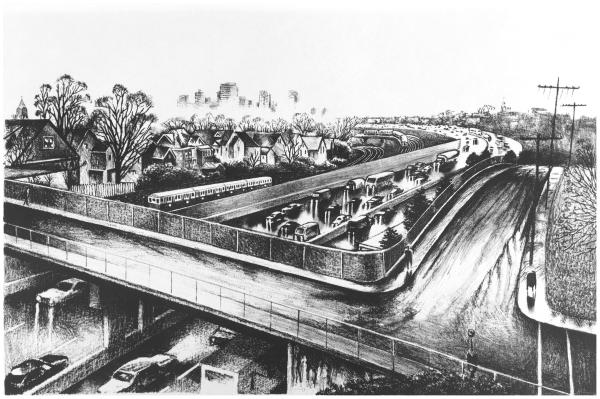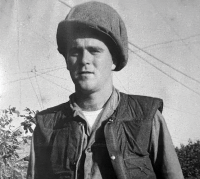November 8, 2023

“Above the Savin Hill Avenue Bridge” lithograph by James Hobin.

Lou Daly, an old friend and sign painter from Fields Corner, once told me that he had no interest in war memorials or days commemorating military victories. Anybody who has been in war only wants to forget it, if they can, said this onetime US Army sergeant who, a long time ago, pushed up the boot of Italy during the Second World War.
Lou’s somber reflection, which families have heard countless times over the generations when their soldiers and sailors and aviators have returned from serving our country in battle, hasn’t stopped the nation from acknowledging their service in a special way.
The first Veterans Day (it was formally known as Armistice Day until 1954) marked the end of the First World War on Nov. 11, 1918. In both wars, Dorchester was one of tens of thousands of homes for heroes who signed up or were enlisted to fight, many of whom never returned. One of them was born and raised in Savin Hill.
In 1917, Henry T. Johnquist, enlisted in the National Guard 9th Massachusetts and was attached to Co. D of the 101st Infantry, mustering at Framingham before going off to France. For all that, he is a virtual unknown. A request for information from the National Military Personnel Records Center came back with nothing. But the Massachusetts Genealogy Honor Roll for Soldiers of the Great War includes this:
“Private Henry T. Johnquist, Dorchester; KIA, whereabouts unknown; date of death, “U.”
That listing is taken from the US Official Casualty Bulletin reported by the commanding general of the US Army in Europe, John J. Pershing, on Mon. Dec. 2, 1918. That’s about all we can know for sure about the life and death by war of Henry T. Johnquist.
Many other soldiers and sailors and flyers were, of course, lost in other wars. As is the case of Henry Johnquist, their hero stories will remain untold fully forever. Still, some stories persist in memories and the record books. One speaks to the story of John T. Marr.
The Catalog of US Military Fatal Casualties of the Korean War from Massachusetts is long enough to bruise a fingertip while you scroll through its 55 pages. Among the citings of valiant young men killed in action is “Marr John T; Service Army; Rank/Rate PFC; Birthdate 1932; County Suffolk; Incident Date 1953 07 19; Recovered Y.”
Soldiers like Lou Daly don’t mind saying that they wouldn’t choose to perish in a foxhole in exchange for a war memorial – even if a favorite street corner could be renamed in their honor. They would pray “No!” They would say that war memorials are for civilians, onlookers who know not; they would say that a war memorial, even the most grandiose, cannot express their sadness.
The American Revolutionary War memorial was done with oil paint on canvas stretched across giant golden frames, whereas Civil War memorials were statues cut from stone or bronze and raised reaching to the sky on either side of the Mason-Dixon line. Nowadays, commemorative art comes in every variety, of course, but the first big move to drop the pedestal happened in 1918, when the “Hero Square,” a simple plaque mounted on a street pole, brought it all home.
From then until now, this plaque, with a soldier’s name beneath a gold star, is dedicated to local heroes who died in the line of duty and set upright in public squares throughout the country. Most people rush by without giving notice, but some people – maybe just enough – stop, look up, read the name, and wonder who, how, when, and where?
Savin Hill has its own Hero Square situated atop a rock face dwarfing the northbound lane of the expressway below. There, in silent tribute amplified by the traffic roaring in the background, an all-weather plaque with a star and gold letters proclaiming “John T. Marr Square” stands tall.
There was a time when I walked by that same spot and the plaque was inscribed with a different name: “Henry T. Johnquist.” It looked like bronze but could have been cast iron. I am left to wonder how the Johnquist namepiece fits into the puzzle of Savin Hill. An online search led to a Hero Square database that locates the original Johnquist plaque at Rockdale Street, which disappeared when things got moved around a lot 70 years ago as contractors split the neighborhood with the new expressway.
“John T. Marr Square” is on the busy spot where the loop of Savin Hill Avenue is cinched. At this intersection, what is under and over and around the “John T. Marr Bridge” spins like a compass needle. The fast pace of this scene is glimpsed in the accompanying pencil drawing that I made from an attic window overlooking the bridge. Near the center of this drawing is the street corner where the Hero Square plaque exists.
John Marr was 20 years old when he entered the US Army and shipped to Korea with the 179th Infantry Regiment, Co. D, near the Bukhan River,12 miles east of Seoul. In 1953, John was stationed in places named Hill 938, Hill 1220, and Christmas Hill. On July 19, PFC Marr and his lieutenant were pinned down by heavy fire. The lieutenant, before moving on to survey the situation, had ordered him to stay undercover, but John, hearing another GI in distress, left his post to give aid and protection. Though still under fire, they managed to get away, but not before John was hit in the leg. At first, it seemed that he would recover, but gangrene set in and he was dead a few days later.
If it is true that mythic heroes are immortal, then maybe that figure floating alongside the Hero Square plaque in my drawing is a signal that, like the postal box on the opposite corner, carries a message. The artist, working from life, is chasing down fleeting impressions for a scene that can be interpreted in as many different ways as the people who see it.
Construction now underway on Savin Hill Avenue has brought with it a barrage of traffic cones and detour signs, one of which has been planted right next to the Hero Square plaque. Large and neon orange, it can’t be missed. It is pure serendipity that as this account draws to a conclusion, a notice on the avenue for a detour has a big black arrow pointing directly to “John T. Marr,” as if he is asking drivers to “turn here to honor Henry, too.”


